
The IEEE Approval of the Spatial Web Global Public Standards: A Technological Awakening for AI
- ByDenise Holt
- July 25, 2024
On July 24, 2024, VERSES AI Inc. announced a groundbreaking achievement: the approval of the Spatial Web Protocol standards — Hyperspace Transaction Protocol (HSTP) and Hyperspace Modeling Language (HSML) — by the IEEE Standards Association. This milestone signals the dawn of a new era for the internet and artificial intelligence (AI), paving the way for the development of a hyper-connected, ethically-aligned network of humans, machines, and intelligent systems.
Laying the foundation for a profound transformation in how we interact with digital systems and how AI will develop in the coming years, this new layer on top of existing internet protocols like HTTP and TCP/IP is set to revolutionize how we interact with both physical and digital worlds.
As we stand on the cusp of this new era, it’s crucial to understand the far-reaching implications of these technologies and their potential to reshape our digital and physical landscape.
The Spatial Web: A New Dimension of the Internet
At its core, the Spatial Web represents the next evolution of the internet — moving from a two-dimensional web of pages and centralized domains to a three-dimensional network of interconnected spaces that are programmable and interpretable over any timescale. This shift enables the creation of a “digital twin” of our physical world, where every person, place, and thing can become a unique domain within the network.
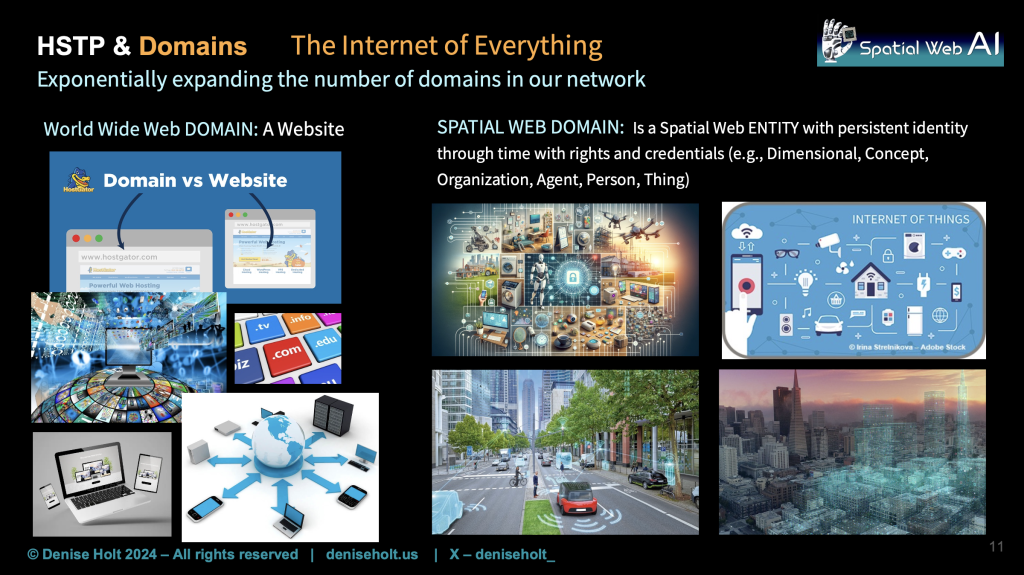
The Spatial Web Protocol: An Overview
The Spatial Web Protocol integrates decentralized technologies, AI, autonomous vehicles, robots, and the Internet of Things (IoT) to create a seamless digital-physical reality. Unlike the siloed and algorithmic nature of current AI systems, the Spatial Web fosters an interconnected network for all entities, programs, and operations to interact seamlessly. This integration is achieved through HSTP and HSML, which provide standard formats for structuring multidimensional information in a unified manner, ensuring interoperability and governance across diverse systems.

Key components enabling this transformation:
1. Hyperspace Transaction Protocol (HSTP)
This protocol acts as both an identifier and gatekeeper for the Spatial Web. It allows browsers to link spaces with unique IDs for every entity, both digital and physical.
HSTP is a generic protocol designed to enable standardized communication between systems within the Spatial Web. It ensures secure and private transactions using encrypted payloads and controlled access to decryption keys. This level of security is crucial for protecting sensitive information and ensuring that only authorized parties can access it. HSTP’s interoperability feature ensures that diverse ecosystems can communicate and interact seamlessly, using internet technology and open standards.
2. Hyperspace Modeling Language (HSML)
This programming language enables the expression of complex relationships and contexts within the Spatial Web. It allows for the creation of “computable context” — a way to encode the properties, relationships, and rules governing objects and spaces.
HSML is a human and machine-readable modeling language that enables the expression and automated execution of legal, financial, and physical activities within the Spatial Web. It consists of several key elements, including entities, activities, agents, contracts, channels, credentials, and domains, all of which work together to represent and enable interactions in the Spatial Web.
3. Universal Domain Graph
HSML allows for the creation of a distributed hypergraph called a Universal Domain Graph (UDG), which stores the relationships between all domains in the Spatial Web, enabling discovery and interaction across the network.
This new architecture addresses many of the limitations of the current internet. It enables true decentralization, enhanced privacy and security, and seamless interoperability between different technologies like augmented reality, virtual reality, Internet of Things devices, and blockchain systems. Each of these emerging technologies that have all been rising together, yet previously siloed, will now become interoperable across our internet.
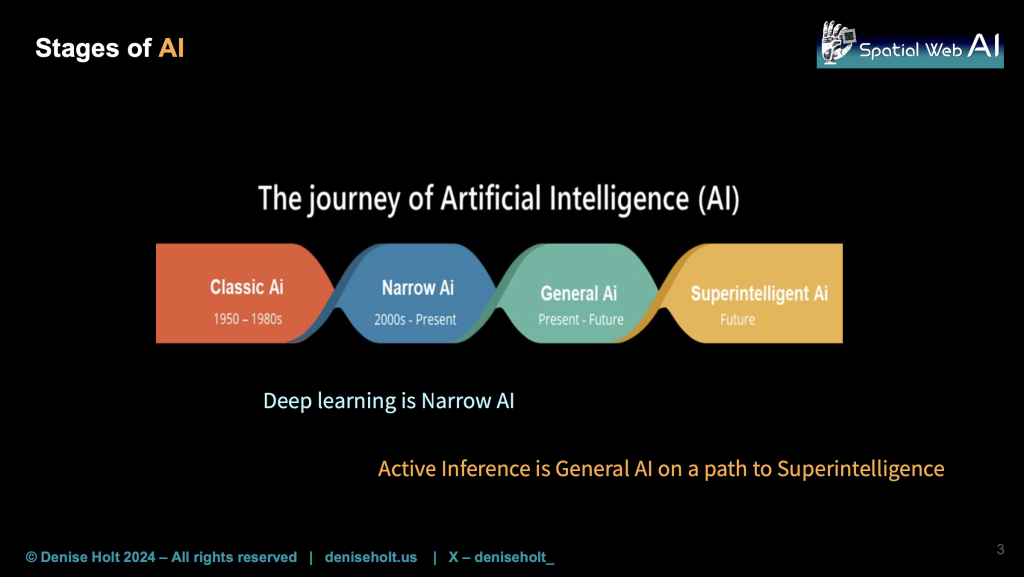
The Impact on AI: From Narrow AI, to AGI, to Super Intelligence
The approval of the Spatial Web standards marks a significant shift towards more advanced and integrated forms of AI. Current AI systems, such as those developed by OpenAI, Meta, Google, et all, rely heavily on machine learning and neural networks, which are essentially software programs with limited interoperability and context-awareness.
In contrast, the Spatial Web facilitates the development of Active Inference AI, which is an entirely new approach to AI — emerging as a potential game-changer in the field. Based on the Free Energy Principle developed by world-renowned neuroscientist Karl Friston, Active Inference represents a fundamentally different approach to autonomous intelligence compared to current machine learning/deep learning models.
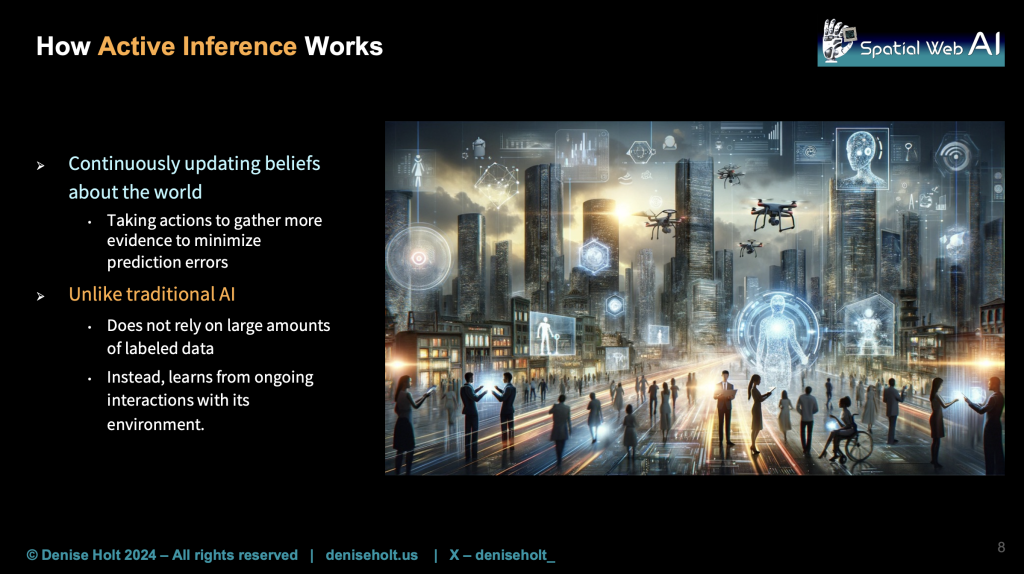
What makes Active Inference AI so different?
1. Biological Inspiration: Active Inference mimics the way biological systems, including the human brain, learn and adapt to their environment.
2. Continuous Learning: Unlike static deep learning models, Active Inference AI continuously updates its understanding of the world based on new sensory input and actions.
3. Explainability: The decision-making process in Active Inference AI is more transparent and interpretable than traditional “black box” neural networks.
4. Energy Efficiency: By focusing on minimizing prediction errors and complexity, Active Inference AI is much more energy-efficient than current AI systems.
5. Contextual Understanding: When combined with the Spatial Web Protocol, an Active Inference AI Agent can develop a rich, contextual understanding of its environment and the relationships between entities/domains. These Agents can also share information and learn from each other.
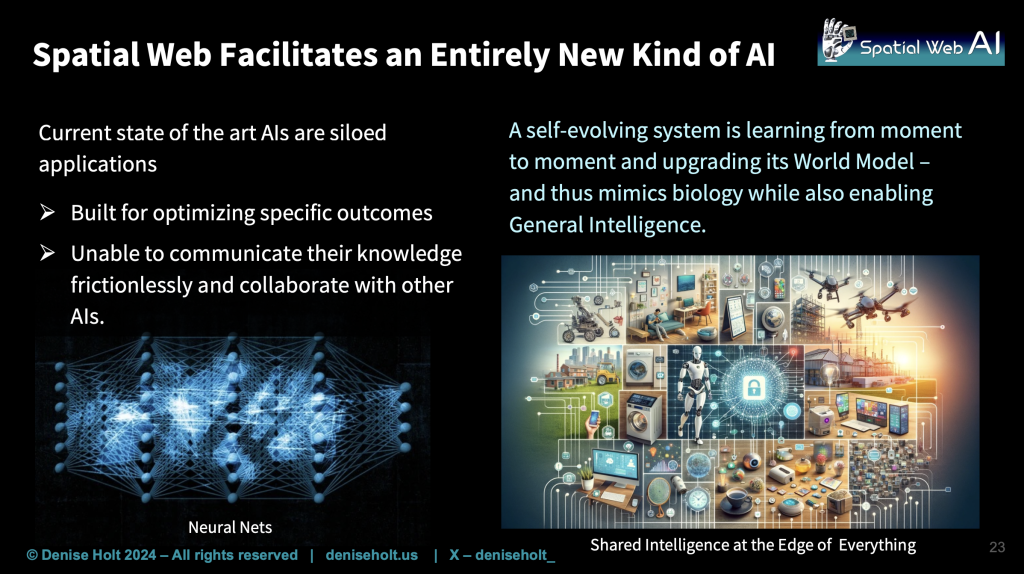
Active Inference AI: A Paradigm Shift in Artificial Intelligence
Active Inference AI operates on principles inspired by natural systems and neuroscience. Unlike traditional AI, which relies on large amounts of labeled data, Active Inference AI learns from ongoing interactions with its environment. This approach enables AI systems to continuously update their models based on new information, improving their ability to handle unforeseen situations and make more accurate and reliable decisions. Active Inference AI is interpretable and explainable, providing greater transparency and trust in its decision-making processes.
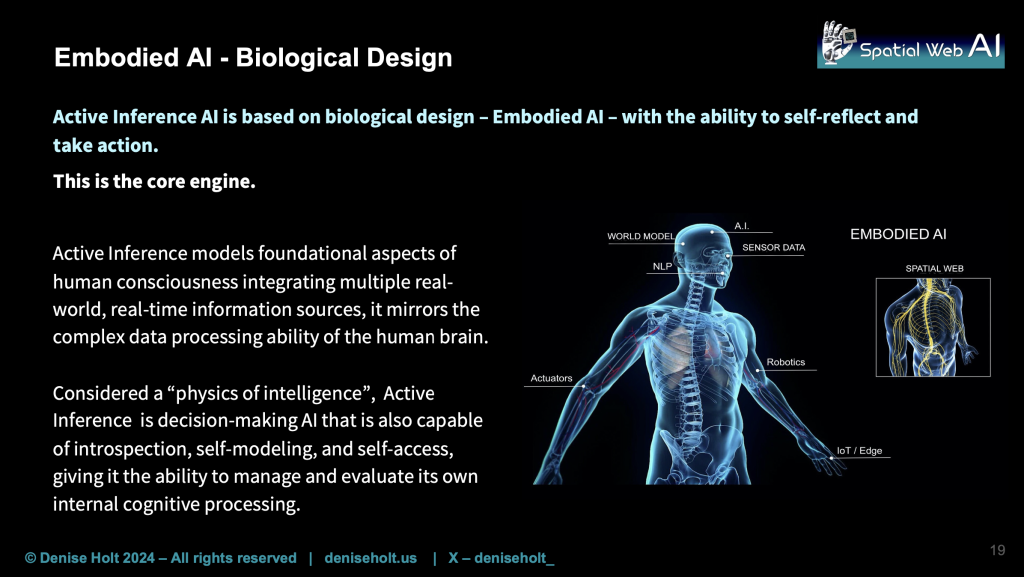
Why Now?
Active Inference has long been thought to be an ideal methodology for AI agents and autonomous systems, but it has also long been thought to be near impossible because it requires a very detailed contextual world model as a grounding for the AI to be able to have a baseline understanding of reality in which to learn and adapt from.
This seemed unlikely, until now. This is exactly what the Spatial Web Protocol, and the standardized digital twinning of our physical world will provide. This is why the development and approval of global public standards around this technology has been so critical toward achieving this milestone.
This next era of our internet — the Spatial Web Protocol — enables the programmable context for the grounding of multitudes of distributed intelligent agents working together across our internet, pushing computational resources to the edge, incorporating real data from anywhere, while maintaining a baseline of real knowledge, enabling an integrated system that is ever-evolving, adaptable, auditable, and functioning in cooperation with human guidance.
The Powerful Synergy of the Spatial Web and Active Inference AI
The combination of the Spatial Web Protocol and Active Inference AI creates a powerful synergy that will revolutionize how we interact with digital systems and the development of autonomous systems.

Some potential impacts include:
- Enhanced Contextual Awareness & Intelligence
Intelligent Agents within the Spatial Web will have access to rich, contextual information about their environment, enabling more sophisticated and nuanced decision-making.
By representing information as locations and relations in hyperspace, the Spatial Web enables context-based cognitive computing. This allows AI systems to understand and interact with their environment more effectively, improving decision-making accuracy and reliability.
2. Interoperability and Standardization
The Spatial Web Protocol provides a common language (HSML) for diverse technologies to communicate, enabling seamless integration of AI systems across different platforms and environments.
HSTP and HSML provide standardized frameworks for AI communication and data exchange, enhancing consistency and reducing errors. This standardization ensures that diverse systems can work together seamlessly, fostering greater collaboration and innovation.
3. Distributed Intelligence
The Spatial Web allows for the creation of multiple, specialized AI agents that can collaborate and share knowledge, potentially leading to more robust and adaptable AI systems.
4. Real-Time Adaptation
AI systems built on these technologies will be able to adapt to changing circumstances in real-time, making them suitable for critical applications like autonomous vehicles, healthcare, and smart city infrastructure.
5. Improved Safety and Governance
The transparency and explainability of Active Inference AI, combined with the programmable nature of the Spatial Web, enables better governance and safety measures for AI systems at every stage of development and capability.
Through HSML, human laws and guidelines can be made programmable for AI systems to understand and abide by in real-time.
6. Security and Privacy
The Spatial Web embeds security and privacy measures within its protocols, ensuring data integrity and protection against malicious activities. This is crucial for maintaining trust in AI systems and protecting sensitive information from unauthorized access.
7. Ethical and Fair Decision-Making
Active Inference AI, supported by the Spatial Web, incorporates ethical considerations into its decision-making processes while preserving diversity and socio-cultural differences. By continuously updating its understanding of the world and minimizing biases, Active Inference AI can promote fair and unbiased outcomes, enhancing the ethical use of AI technologies.
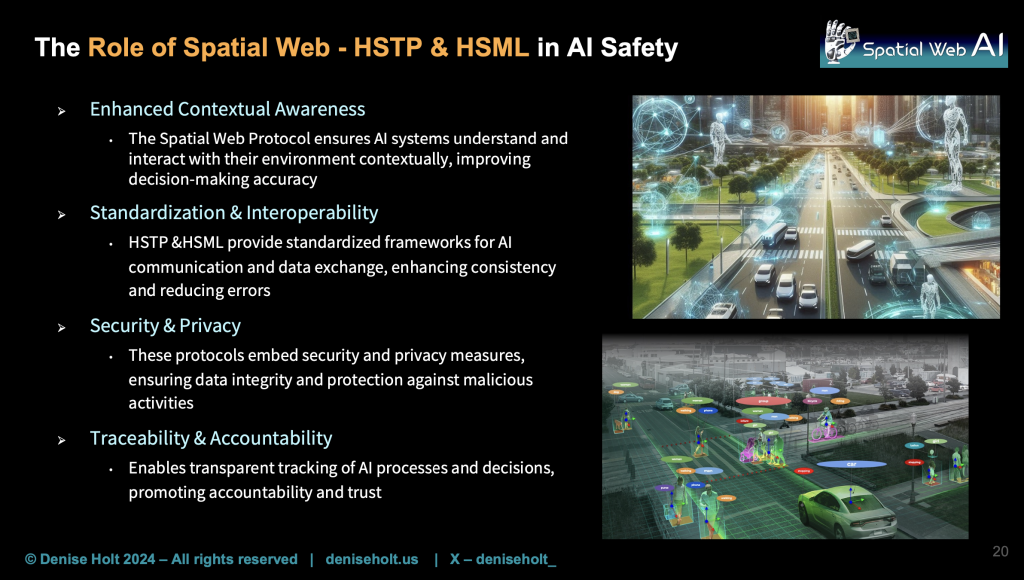
First Principles, Embodied, and Decentralized AI: The Future of AI and Computing
The integration of the Spatial Web Protocol standards heralds a new era of decentralized, Intelligent Agents capable of learning and adapting in real-time. This shift towards First Principles AI, Embodied AI, and Decentralized AI distributes AI computing to Edge devices, and represents a profound transformation in how we interact with technology and the world around us.
In the Gartner Hype Cycle for Artificial Intelligence 2024, published a week ago, Gartner included VERSES as a leader in First Principles AI, due to their ongoing and groundbreaking development of Active Inference AI with Dr. Karl Friston as their Chief Scientist, but what Gartner seems to have missed is that Active Inference coupled with the Spatial Web enables Multi-Agent Systems, Embodied AI, Decentralized Autonomous Systems, Edge AI, Responsible AI, AI Simulation, Causal AI — literally nearly all of the upcoming AI methodologies represented in their chart as approaching the peak of their hype cycle.
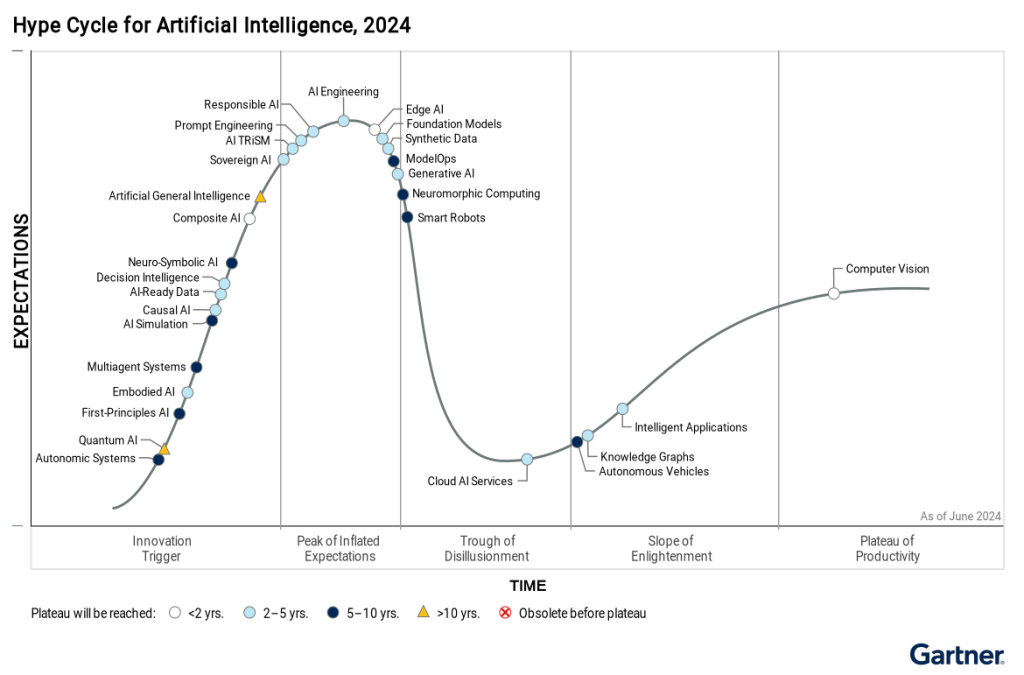
Last year, this same report from Gartner in summer of 2023 had already shown Generative AI at its peak. Additionally, over this past year and a half, AI leaders across the globe have been proclaiming that another breakthrough is needed to be able to achieve AGI (Artificial General Intelligence) and eventually ASI (Artificial Super Intelligence) — admitting that deep learning alone is not capable of getting us there.
It seems to me that VERSES AI may well have achieved that breakthrough in this novel approach of theirs that is based on neuroscience, rather than the machine learning engineering approach that has remained the standard for the past 30 years.
By completely rethinking computing, beginning with the very network that connects all people, data, and devices, and through it, incorporating a contextual global grounding for all AI systems to be able to grasp and understand the current state of reality for all things in all environments through the Spatial Web Protocol, and by taking a biological approach to cognitive computing that incorporates reasoning and action, they have reimagined a pathway to autonomous intelligence that is flexible, adaptable, and able to emerge and grow in knowledge similar to human intelligence.
Real-World Applications and Impact
The implications of these technologies span across numerous industries and aspects of daily life:
1. Smart Cities: The Spatial Web will serve as the underlying infrastructure for smart cities, enabling efficient management of resources, traffic, and public services through a network of interconnected AI agents.
2. Smart Healthcare: Personalized medicine will be revolutionized through AI agents that can access and interpret vast amounts of contextual health data, leading to more accurate diagnoses and tailored treatments.
3. Smart Education: Adaptive learning systems can be created that adjust in real-time to a student’s progress and learning style, providing truly personalized education.
4. Smart Manufacturing and Logistics: The combination of IoT devices, AI agents, and the Spatial Web will enable highly efficient and adaptable manufacturing and supply chain processes.
5. Smart Environmental Monitoring: A network of AI agents can continuously monitor and respond to environmental changes, aiding in conservation efforts and disaster prevention.
6. Virtual and Augmented Reality: The Spatial Web provides the perfect backdrop for more immersive and interactive VR and AR experiences, blending the digital and physical worlds seamlessly.
Towards a Smarter, More Connected World
Over the past four years and countless hours, the teams at VERSES AI and the Spatial Web Foundation, along with the many distinguished global members of IEEE Spatial Web Protocol, Architecture, and Governance Working Group, have accomplished a remarkable feat in achieving this milestone of approval for the global public standards for this new expansion of our internet — The Spatial Web.
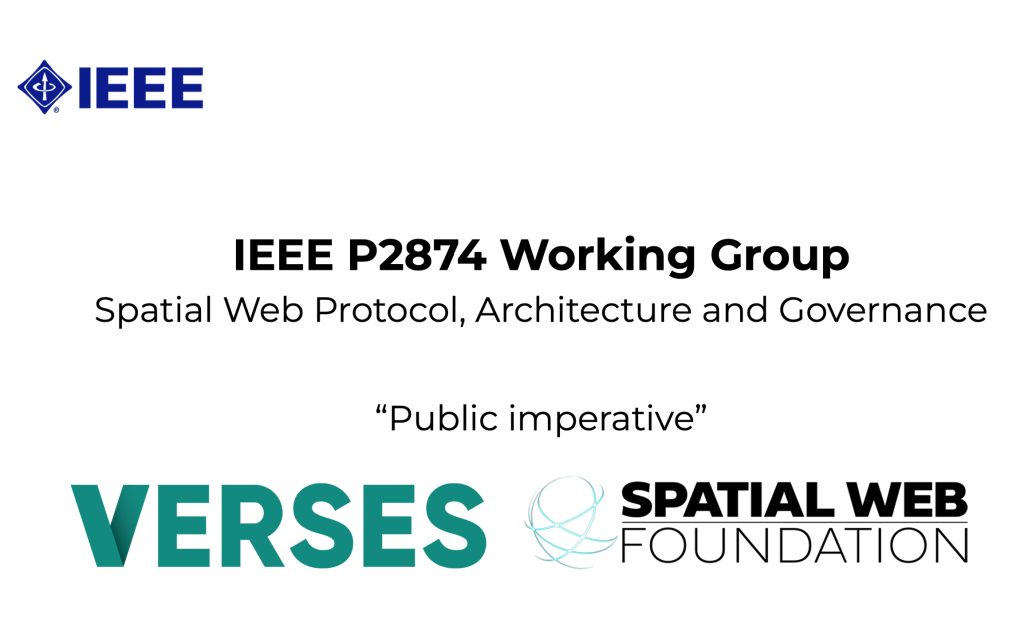
VERSES’ new platform, Genius™, will be the first public interface in which everyone can experience these expanded capabilities of the internet coupled with Active Inference to facilitate the development of a network of collective distributed intelligence, where scores of individual and specialized intelligences — both human and machine — come together on a common network. This interconnectedness will allow for the sharing of real-time knowledge and the evolution of a global understanding, mirroring the way humans learn and grow through shared experiences and information.
Genius™ is currently operating in beta to selected developer community, with plans to become publicly available early 2025.
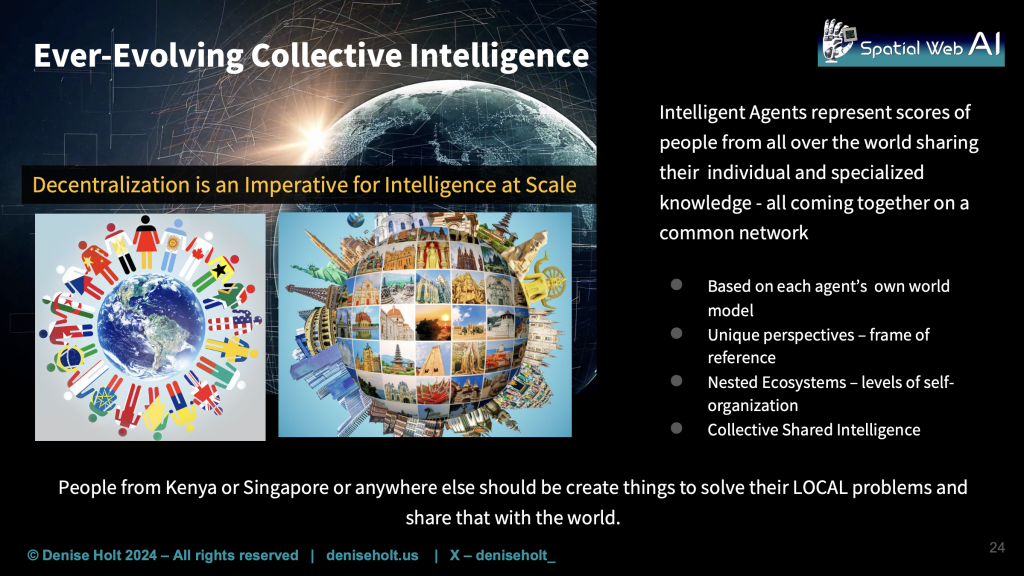
A Technological Awakening
The approval of the Spatial Web Protocol standards by the IEEE represents a monumental leap forward in the evolution of computing and AI across our global internet. These technologies have the potential to create a more intelligent, adaptive, and interconnected digital world, transforming numerous aspects of our lives and industries.
By enabling seamless interaction between physical and digital worlds, fostering interoperability, and promoting ethical AI, the Spatial Web sets the stage for a future where Intelligent Agents can operate autonomously and collaboratively across diverse domains possessing real awareness and understanding in the moment. As we move towards this new era of computing, the potential for innovation and positive impact on global industries and everyday life is enormous.
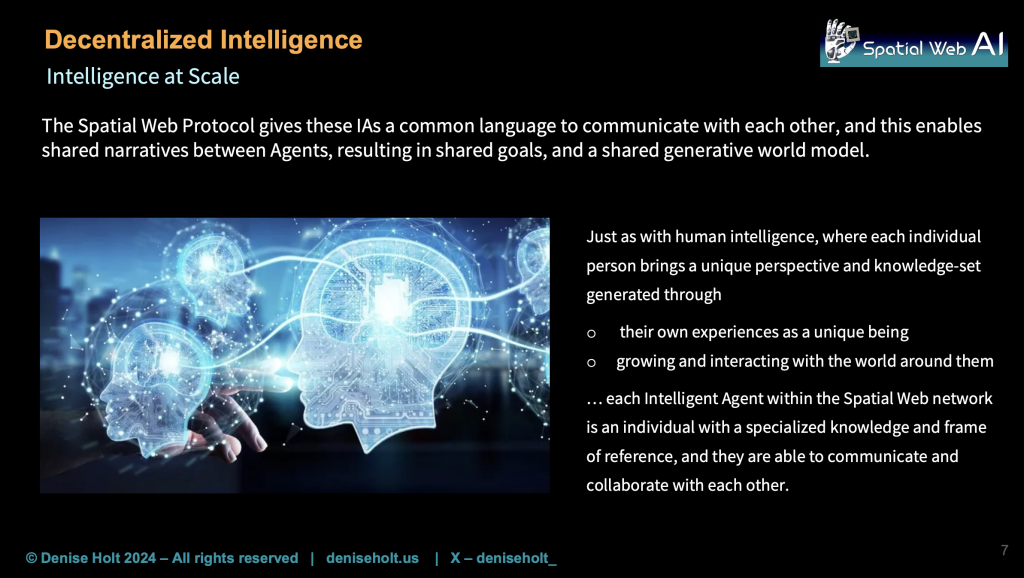
The future of computing is no longer just about faster processors or bigger data centers. It’s about creating a digital environment that can understand, adapt, and evolve alongside us. The Spatial Web and Active Inference AI are the first steps towards this future, opening possibilities that were once the realm of science fiction. As these technologies continue to develop and mature, we will inevitably find ourselves on the cusp of a new technological revolution — one that will be as transformative as the invention of the internet itself.
Explore the future of Active Inference AI with me, and gain insights into this revolutionary approach and groundbreaking research!
Ready to learn more? Join my Substack Channel for the Ultimate Resource Guide for Active Inference AI, and to gain access to my exclusive Learning Lab LIVE sessions.
Visit my blog at https://deniseholt.us/, and Subscribe to my Spatial Web AI Podcast on YouTube, Spotify, and more. Subscribe to my newsletter on LinkedIn.

Join my Substack Channel
Substack is where our community thrives!
Become a paid member, and join us for Learning Lab LIVE!
Join the conversation of this cutting edge, safe, and trustworthy new approach to AI.
